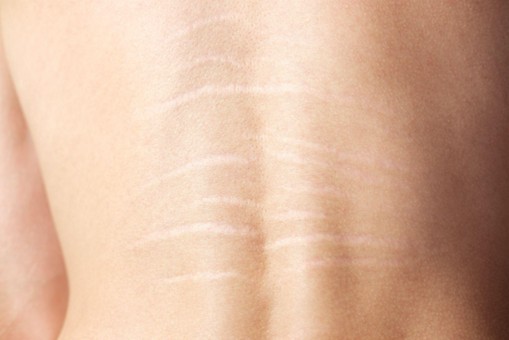-
 mederma@winmedicare.com
mederma@winmedicare.com
- No.1 Dermatologist Recommended Scar Brand
-
 Login
Login

Stretch marks on the back are a common skin concern that can appear during periods of rapid growth, weight changes, or muscle development. They often emerge during periods of rapid physical changes, such as growth spurts, significant weight fluctuations, or hormonal shifts.
These marks are typically associated with the skin’s inability to keep up with the underlying changes, leading to the formation of visible lines. These marks, while harmless, often lead people to seek effective ways to reduce their appearance.
Are stretch marks inevitable, or can they be prevented and treated? In this blog, we’ll look at what stretch marks are, why they occur, and how to get rid of stretch marks on the back using effective solutions.
Stretch marks, medically known as striae, are a type of scar that forms when the skin is stretched too quickly. This rapid stretching damages collagen and elastin fibres in the dermis, the deeper layer of the skin. When these fibres tear, the body’s natural healing process creates stretch marks.
These scars can range from reddish or purple marks when they are fresh to silvery or white marks as they mature. Unlike scars from injuries or acne, stretch marks are caused by skin overstretching and are not indicative of damage to the outer skin layer. They often resemble atrophic scars, which are caused by tissue loss, but they are less severe.
Also Read – Dealing with Stretch Marks After Weight Loss
Stretch marks on the back are typically thin, elongated lines that initially appear raised and reddish or purplish. Over time, as they mature, they become flat and lighter in colour, blending into the surrounding skin. These marks are most common on the lower back, where the skin is more prone to stretching.
In teenagers, stretch marks may appear darker and more prominent due to rapid growth during puberty. While these marks are harmless, their visual impact often drives people to explore remedies. Fortunately, our solutions can help fade stretch marks while keeping the skin healthy and hydrated.
Stretch marks on the back can result from a variety of causes. Understanding these can help identify ways to manage or reduce their appearance:
Also Read – Know How to Get Rid of Stretch Marks from Working Out
Stretch marks on the back are more likely to develop in individuals experiencing significant changes in their bodies. Rapid growth during adolescence, fluctuations in weight, hormonal shifts during pregnancy, or intense physical training can all contribute to their appearance.
Additionally, genetic predisposition and certain medical conditions that affect skin elasticity may increase susceptibility. Being aware of these factors can help in taking preventive measures or exploring treatment options to manage stretch marks effectively.
Although it may not be possible to prevent stretch marks entirely, you can take steps to minimise their occurrence:
By adopting these measures, you can significantly reduce the likelihood of developing stretch marks on your back.
Reducing stretch marks on the back involves a combination of effective ingredients and consistent application:
There are times when consulting a dermatologist is essential:
A dermatologist can provide tailored solutions to address stretch marks effectively.
Your Path to Smoother Skin Starts Today
Stretch marks on the back, whether caused by teenage growth spurts, pregnancy, or muscle gain, are a natural part of life. With proper care and the right products, their appearance can be reduced.
Our paraben-free stretch marks cream is safe for use during pregnancy and breastfeeding and can effectively fade old scars over time. Consistent use of any product is key. Explore our options and embrace healthy, hydrated skin with our expert solutions. We’re here to support your journey to skin confidence.